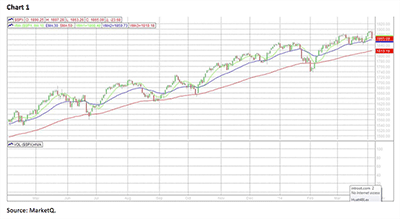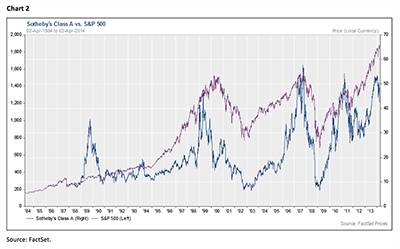“The Russians Are Coming”
by Jeffrey Saut, Chief Investment Strategist, Raymond James
April 7, 2014
The Russians Are Coming, The Russians Are Coming is a 1966 American comedy film directed by Norman Jewison and based on Nathaniel Benchley’s book The Off-Islanders. The movie tells the Cold War story of the comedic chaos that happens when a Soviet submarine runs aground closely offshore a small island town near New England and the crew is forced to come ashore. At the time I saw the movie I was summering at my family’s home on Nantucket Island, which really brought home the ambiance of the movie since the landscape looked remarkably similar to places on Nantucket. Last Friday, however, rumors that the “Russians are coming” swirled down the canyons of Wall Street, causing a late Friday Fade that left the S&P 500 (SPX/1865.09) down an eye-popping 24 points. The rumors went something like this. Vladimir Putin is going to invade the rest of the Ukraine over the weekend because of what is getting ready to happen. According to The Wall Street Journal, “NATO foreign ministers this week directed Gen. Breedlove to craft a response plan, which could include moving NATO equipment and troops into Eastern Europe, beefing up exercises, surveillance and patrols, and speeding up NATO's rapid-response force.” Putin’s worry is that when those troops are moved into such a tactical position, Ukraine’s remaining government will use that opportunity to announce a coalition with the west and potentially petition for membership in the European Union. Whether those rumors turn out to be true remains to be seen, but that is what whacked stocks late Friday afternoon and very few pundits even picked up on it. What was interesting to me is that once my 1872 S&P 500 short-term “failsafe” point was violated to the downside, the selling intensified. This is not an insignificant point because, as repeatedly stated last week, “There is a full charge of internal energy built up in my indicators suggesting if a stock market move begins, it has enough energy to turn into a meaningful move.” I had thought said energy would likely be released on the upside with a peek-a-boo “look” above 1900, but last Friday’s action calls that into question unless “John Wayne” again rides to the rescue.
For weeks I have said that something just does not feel right about this market, but every time I made that statement John Wayne has indeed ridden to the rescue to buoy stocks. This occurred at the March 14th low, and again at the March 27th low, both of which stabilized stocks around the SPX’s 30-day moving average (DMA). Interestingly, at last Friday’s close the SPX was resting marginally above the 30-DMA once again, which now resides at 1863.86. Therefore, the first part of this week shapes up as a pretty important timeframe. If the SPX holds above its 30-DMA, then the rally could resume. If it doesn’t, the often mentioned 1835 – 1840 zone support level again comes into play, which has held three times since the beginning of March, and failing that the 1780 – 1800 level becomes the target zone. Longer term, I continue to believe a secular bull market is afoot that has years left to run.
To that point, in Friday’s Morning Tack I wrote the following:
Nevertheless, a lot of folks believe the stock market has come too far, too fast, and the upside is currently limited. To that point, JP Morgan’s strategist, Dr. David Kelly, hosted a conference call yesterday to allay such fears. The call began with him explaining the economic expansion will be five years old this June. However, he thinks we are into a long, but slow, expansion that has years left to run. Moreover, he stated we are not close to any of the excesses that lead to a recession. While he said the upcoming GDP figures will likely be soft, March figures will show the softness is weather induced. He emphasized while stocks are not as cheap as they were in 2009/2010 (see chart 1), they are still not expensive when compared to cash/bonds. If he had to own bonds, which are in a bear market, he would consider emerging market debt. With $1.9 trillion on the sideline, Dr. Kelley opined there is plenty of “dry powder” to move stocks higher. The JP Morgan mutual fund that was mentioned to take advantage of Dr. Kelly’s views was JVASX. There were numerous other positive points he made, but I am out of space and will try to highlight them in next Monday’s longer strategy report.
Well, it’s “next Monday,” and I will attempt to make good on that promise. Dr. Kelly said that he thinks the Fed is “over cooking” the economy by staying too easy for too long. The result should be a pickup in inflation and higher interest rates. He noted we have almost recaptured all the jobs lost in the downturn, implying an increase in capital expenditures (capex) and an increase in wage pressures (read: inflation). Of interest is that monetary policy leads, while the effects of inflation and employment lag. Europe, he noted, has declining headwinds and is therefore attractive. On emerging markets (EM), they remain “cheap” and are set up for outsized growth over the next three to five years. In our Gleanings report this month, as well as the Investment Strategy Quarterly, we outline the case for EM, and suggest a scaled “in” buying approach. To wit, if you have a $100,000 asset allocation for EM we think you should break that into four $25,000 tranches and buy the first tranche today. Then wait two to three months and buy the second tranche and so forth until the $100,000 allocation is complete. Dr. Kelly opined over the long-term the bullish case for EM rests on: 1) the need for capital growth; 2) labor force growth; and, 3) total factor productivity. He made a strong case for EM, and after strongly recommending EM in 2001 when China joined the World Trade Organization (WTO), we stepped off that theme two years ago for various reasons. Now we agree with Dr. Kelly. As a sidebar, one of the mutual funds mentioned as a way to participate in Dr. Kelly’s themes was the JP Morgan Value Advantage Fund (JVASX/$28.09). The charts to support all of Dr. Kelly’s points may be found at their website (https://www.jpmorganfunds.com) using the search engine’s key word “Guide to the Markets.”
As for the stock market, since the beginning of the year I have written that following a 40%+ rally like we have experienced from the June 2012 low, without any meaningful correction (10% or more), the median historical drawdown is between 5% and 7% over the next three months and between 10% and 12% sometime over the next 12 months. But, such a drawdown/pullback should be viewed within the context of a secular bull market. Well, we had a 6.2% pullback between the intraday high of 1/21/14 and the intraday low of 2/5/14. That means sometime in the next eight months we should see a 10% to 12% pullback, if past is prelude. Whether Friday was the start of such a pullback is unknowable at this point. I will note that Friday was what a technical analyst would term an outside bearish reversal day. Recall that such a day occurs when a price chart pattern of a security's high and low prices for the day exceeds those of the previous trading session. The outside reversal pattern is called by candlestick chartists a "bearish engulfing" pattern if the second bar is a down candlestick; and, that’s exactly what we got last Friday (see chart). Also of interest is that the NASDAQ Composite (COMPQ/4127.73), which has bounced repeatedly off of its 100-DMA for nearly a year, fell below that moving average on Friday. Other worries include that for nearly a year “Payroll Friday” has seen the SPX rally no matter what the condition of the market, the rotation out of the high flyers into more value type stocks, the fact that the selling of high flyers typically precedes more selling in the overall stock market, that historically markets decline during the second and third quarters of a mid-term election year, and the list goes on. That said, I continue to believe any decline should be viewed within the construct of a secular bull market.
The call for this week: I am in NYC seeing accounts and doing media, and if past is prelude something BIG will occur in the stock market in my absence. As stated, there is a full charge of energy in my proprietary indicators, so if a move starts, in either direction, it has enough energy to become meaningful. This morning, the Russian Rumors, which swamped stocks on Friday, indeed proved fallacious. Nevertheless, the preopening futures are down about 6 points (at 5:00 a.m.), begging the question, “Are we going to get another immediate upside reversal like we have seen every other time it looked like stocks were geared for the downside?” Still, as can be seen in chart 2, Sotheby’s has tended to “call” bubbles in the past. If that holds, we are NOT currently in a bubble.
Copyright © Raymond James

















